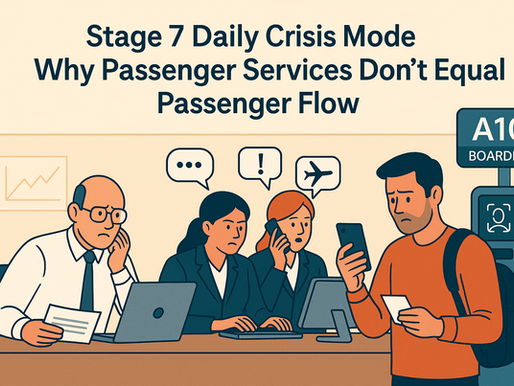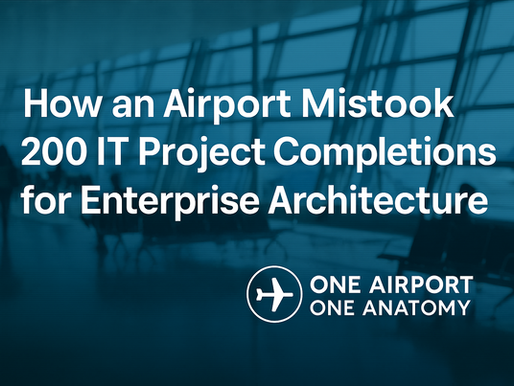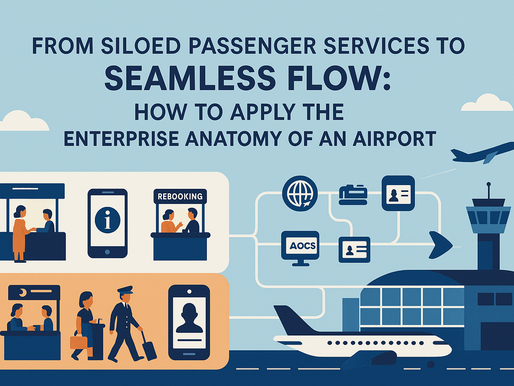top of page
Enterprise Intelligence
Transforming Strategy into Execution with Precision and Real Intelligence


Stage 7 Daily Operational Crisis Mode: Why Passenger Services Don’t Equal Passenger Flow: Daily
Stage 7 exposes the final structural absence: Passenger Flow has never been architected end-to-end.
Thirteen strategies existed, but only one was decomposed.Twelve processes operated in silos.
Thirty-three rules scattered across configs.Twelve+ systems delivered as isolated components. Twenty-two projects deployed without enterprise flow.
And finally, daily operations prove the absence — with manual overrides, delays, and flat NPS.

Sunil Dutt Jha
Aug 11


Stage 6 Projects Implementation Without Flow : Why Passenger Services Don’t Equal Passenger Flow:
Stage 6 exposes the fifth structural absence: implementation without flow. Passenger Services didn’t fail to deploy. They failed to map projects to strategies, processes, rules, and coordinated behavior.
Until implementation is measured by enterprise outcomes — not by delivery milestones — airports will keep declaring “project success” while Passenger Flow stays broken.

Sunil Dutt Jha
Aug 8


Stage 5 Isolated Components: Why Passenger Services Don’t Equal Passenger Flow
Stage 5 exposes the fourth structural absence: components were delivered, but not architected together. Airports didn’t fail to buy systems or roll out apps. They failed to design those systems as one anatomy.
Until components share contracts, expose logic, and are tested as a connected flow, Passenger Services will keep running on overrides and crisis fixes.

Sunil Dutt Jha
Aug 7


Stage 4 Fragmented System Logic : Why Passenger Services Don’t Equal Passenger Flow
Passenger Flow doesn’t just depend on processes — it depends on the logic rules inside systems: how upgrades are applied, how identities are verified, how disruptions are managed, and how compliance is enforced.

Sunil Dutt Jha
Aug 6


Case USA17: How an Airline Alliance Masked Loyalty Program Upgrades as Enterprise Architecture Work 💲
In aviation alliances, loyalty upgrades are sold as EA. Tiers, points, and partner accrual improved — yet scheduling, ops control, and pricing logic remained disconnected from loyalty behavior.

Sunil Dutt Jha
Aug 4


Stage 3 Broken Process Landscape: Why Passenger Services Don’t Equal Passenger Flow
Stage 3 asks: What enterprise processes intersect with Passenger Services, and how many are actually modeled, cross-linked, and mapped to supporting systems?
The finding: Passenger Flow depends on at least 12 critical processes — yet only 2 are modeled, and none are structurally connected across departments.

Sunil Dutt Jha
Aug 4


USA33: How an Aviation Tech Vendor Rebranded Platform Orchestration as Enterprise Architecture
n aviation technology, a recurring pattern is branding platform orchestration as enterprise architecture.
Vendors demonstrated that their platform could connect booking, baggage, and departure systems — yet the enterprise structure across airlines, airports, regulators, and service partners was never defined.

Sunil Dutt Jha
Jul 31


How an Airport Mistook 180 IT Project Completions for Enterprise Architecture
This airport executed 200+ projects across 15 core functions. What looks like progress is activity, not evolution. When transformation is measured by project completion — but no one can say what the airport’s structure now looks like — you don’t have architecture. You have outputs.

Sunil Dutt Jha
Jul 31


Case USA10: How an Airline Group Mistook App Launches for Enterprise Architecture Transformation
Airline groups launched sleek passenger apps with booking, check-in, and loyalty features, framing them as proof of EA maturity. Yet the backend systems — scheduling, crew management, pricing — remained unaligned, requiring manual reconciliation for many transactions.

Sunil Dutt Jha
Jul 30


Stage 2 Missing Strategy Decomposition: Why Passenger Services Don’t Equal Passenger Flow
What strategic intents actually shape Passenger Services, and how many have been structurally decomposed into process flows, rules, and systems?

Sunil Dutt Jha
Jul 30


From Siloed Passenger Services to Seamless Flow: How to Apply the Enterprise Anatomy of an Airport
What’s missing is structure — the Enterprise Anatomy of an Airport — a model that connects strategy, process, logic, systems, and operations into one coherent passenger flow.
Until this structure exists, Passenger Services will keep compensating with manual overrides, side spreadsheets, and crisis-mode fixes — draining resources, delaying flights, and eroding customer trust.

Sunil Dutt Jha
Jul 18


Why Airport CIOs Must Rethink IT Architecture – 10 Missing Links in the Airport IT Operating Model
Yet despite all Digital IT, transformation fatigue is rising. Projects stall midstream. New services take quarters instead of months. Regulatory audits trigger unplanned rework. Passenger experience remains inconsistent. And automation, though visible, rarely scales.

Sunil Dutt Jha
Jul 16
bottom of page
